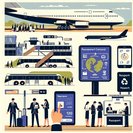
Tourism Minister Celso Sabino on 12 November 2025 unveiled a major upgrade to Brazil’s electronic-visa (e-Visa) system, cutting advertised processing times from ten calendar days to “under 48 hours” for applicants from more than 90 countries, including key long-haul markets such as the United States, Canada and Australia.
Key features – The revamped portal, built in partnership with state-owned data-processing firm Serpro, uses biometric matching and AI-powered fraud detection to reduce manual reviews. A new dashboard lets travelers track application status in real time and download an airline-verifiable QR code once the visa is issued.
![Brazil Overhauls E-Visa Platform, Promises 48-Hour Processing and Future Visa-on-Arrival Option]()
Strategic objectives – Officials said faster visas are critical to regaining competitiveness after a sluggish 2025 inbound season. International arrivals remain 12 percent below 2019 levels, and industry analysts blame visa friction for Brazil’s under-performance relative to Colombia, Peru and Argentina. The upgrade coincides with an advertising push promoting Amazon and Pantanal eco-itineraries as well as urban breaks in Rio and São Paulo.
What’s next – Sabino confirmed that a pilot “digital visa-on-arrival” will launch at São Paulo-Guarulhos and Rio Galeão airports in early 2026, allowing eligible travelers to complete biometric enrolment and pay fees at self-service kiosks. If successful, the model will roll out nationwide ahead of the FIFA Women’s World Cup qualifiers in mid-2026.
Implications for corporates – Shorter lead times should help global-mobility teams accommodate urgent meetings and technical interventions. Employers are advised to test the new system and update internal checklists; early users report that high-resolution passport scans and proof of onward travel remain mandatory. Companies hosting large events should monitor the visa-on-arrival pilot, which could ease last-minute delegate travel once expanded.
Key features – The revamped portal, built in partnership with state-owned data-processing firm Serpro, uses biometric matching and AI-powered fraud detection to reduce manual reviews. A new dashboard lets travelers track application status in real time and download an airline-verifiable QR code once the visa is issued.

Strategic objectives – Officials said faster visas are critical to regaining competitiveness after a sluggish 2025 inbound season. International arrivals remain 12 percent below 2019 levels, and industry analysts blame visa friction for Brazil’s under-performance relative to Colombia, Peru and Argentina. The upgrade coincides with an advertising push promoting Amazon and Pantanal eco-itineraries as well as urban breaks in Rio and São Paulo.
What’s next – Sabino confirmed that a pilot “digital visa-on-arrival” will launch at São Paulo-Guarulhos and Rio Galeão airports in early 2026, allowing eligible travelers to complete biometric enrolment and pay fees at self-service kiosks. If successful, the model will roll out nationwide ahead of the FIFA Women’s World Cup qualifiers in mid-2026.
Implications for corporates – Shorter lead times should help global-mobility teams accommodate urgent meetings and technical interventions. Employers are advised to test the new system and update internal checklists; early users report that high-resolution passport scans and proof of onward travel remain mandatory. Companies hosting large events should monitor the visa-on-arrival pilot, which could ease last-minute delegate travel once expanded.











